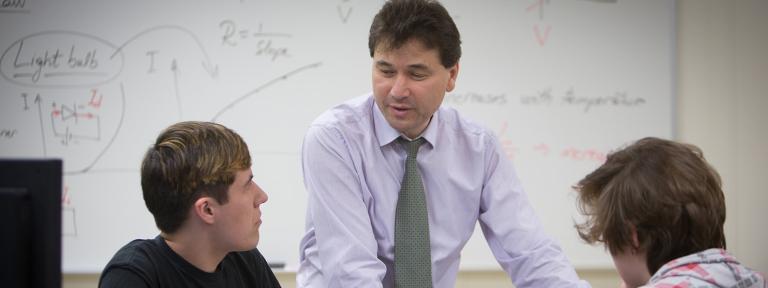
Hopping a space shuttle to visit other planets may not be unrealistic in the near future, if three Kettering University researchers have anything to say about it. They focus on the small things, like the build-up of positive ions in a thruster, so big things like satellites can move faster through the galaxy.
They explore the inner reaches of outer space travel in the Computational Plasma Dynamics Laboratory (CPDL), the first dedicated space-related research environment at Kettering. Plasma physics and propulsion research is the primary mission of the CPDL.
"I've always been a space cowboy at heart," said Dr. K. Joel Berry, department head for Mechanical Engineering at Kettering, explaining his role in computational plasma dynamics research projects for the National Aeronautics and Space Administration (NASA) being conducted in the "NASA" lab at Kettering.
The lab is the brainchild of Dr. Berry and Dr. Subrata Roy, assistant professor of Mechanical Engineering and director of the CPDL. "Dr. Roy found out I was doing some preliminary work in magnetohydrodynamic analysis. He received a NASA fellowship, secured multi-year NASA research grants and from there we developed a plan to institute the CDPL at Kettering," said Berry.
In addition to Berry and Roy the research team includes Dr. Birendra Pandey, post doctoral research fellow for the NASA lab; four graduate and one undergraduate students.
The goals of the lab include promoting the exchange of the latest scientific and technical information to improve efficiency of high altitude and orbital space missions by understanding the dynamics of plasma. The lab will also provide students an opportunity to study high-speed propulsion, plasma physics and related technologies using advanced computational tools.
Research on space missions in real time and conditions involve a lot of resources. Computational methods allow scientists to simulate various conditions of temperature, pressure in mathematical models, to find efficiencies over a large range of operating conditions. These computational tools allow research to be done faster and more accurately than in the past.
"There is more resolution and detail," said Pandey.
"The simulations we're doing in the lab are based on the same fundamental principles as those involved in the formation of the galaxy," said Pandey. "We can look at our findings related to the dynamics of plasma and apply them to broader subjects."
Current research projects in the CPDL include three areas: on-board propulsion, plasma physics and computational fluid dynamics. Various forms of funding for the research comes from NASA's Glenn Research Center for On-Board Propulsion, the Air Force Office of Scientific Research (AFOSR), the National Science Foundation (NSF), and the National Partnership for Advanced Computational Infrastructure (NPACI).
"The study of on-board propulsion systems is hot right now," according to Roy. "In another 25 to 30 years people will want to travel to other planets as our horizon of curiosity and adventure expands. We need to develop cost-effective devices that will take us there."
"There is tremendous industrial interest in Hall Thruster technology and MPD (magnetoplasmadynamic) technology, for future inter-planetary space missions," Roy said.
Hall Thrusters are currently not efficient in the way plasma interacts with propellant. Roy is researching how to improve the power generated by medium to high-power electromagnetic thrusters for in-orbit station keeping and maneuvering. One of his long-term goals is to have the Kettering University seal on a space shuttle hull with other NASA research partners.
Expanding CPDL research efforts into the area of plasma sheath modeling enables the Kettering scientists to understand plasma physics better, and ultimately improve the design and effectiveness of all thrusters, according to Roy.
Using computer simulations of the space near the wall of a thruster container, Drs. Berry, Roy and Pandey can model the build-up of positive ions (the sheath) that create resistance. Using numerical computation to determine the physics of what happens in the sheath, they can design thrusters with more efficient propulsion using less power.
The third area of research in which the CPDL is currently involved is computational fluid dynamics. Dr. Berry is working on the application of finite element-based computational technology for magnetoplasmadynamic thruster simulations. Additional research in the CPDL includes element-based numerical algorithm development for magnetohydrodynamic applications.
As soon as they can secure funding, future CPDL research will extend into the area of solar astrophysics and self-gravitating plasma, a move made possible because of Pandey's expertise, according to Roy.
"We're very lucky to have Dr. Pandey. He has a strong background in theoretical physics, which compliments mine and Dr. Roy's backgrounds in computational methods," Berry said.
Other long-term goals for the CPDL include expanding the lab facilities, developing a subset of the curriculum to allow graduate studies in astro-physics at Kettering, development of additional courses in electromagnetic-physics and plasma dynamics, and to help students prepare for careers in space science.
"We would like to develop more research facilities like the NASA lab to allow faculty and students an opportunity to work in a similar collaborative environment," said Berry.
"The enthusiasm at Kettering is very infectious," said Pandey of working in the CPDL. "It keeps you asking questions, and if you're fascinated by your subject you do research to answer your own questions."
"It really, truly is a fascinating world. If it wasn't, we wouldn't be spending sleepless nights here in the lab trying to understand it," Roy said.